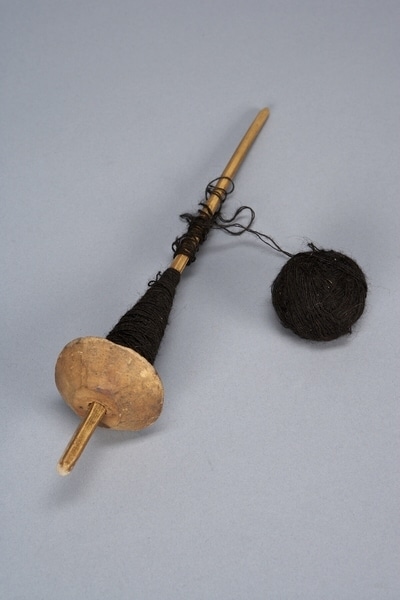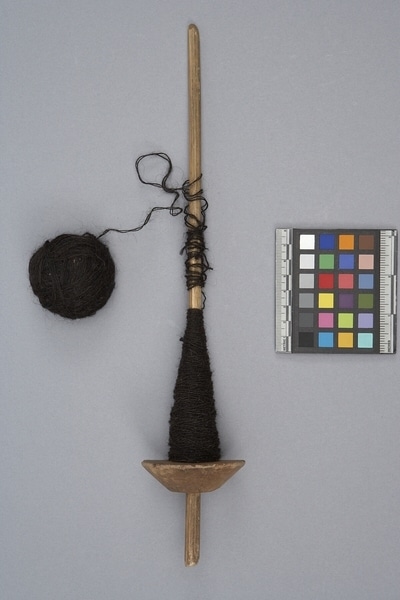Plying Spindle Item Number: Sf1022 from the MOA: University of British Columbia


Description
Spindle, consisting of a wooden shaft with a cone shaped whorl near one end with a conical, wrapped section of plied yarn resting on the flat surface of the whorl. The middle of the shaft has a section of losing wound, plied yarn which is attached to a compactly wound round ball of paired yarns. The yarn wound around the shaft is tightly plied while the yarn in the ball is not plied.
History Of Use
The 'kantina' or plying spindle is heavier and larger than the spindle used for spinning. It will keep spinning for longer and is not likely to break a yarn that is doubled or trebled. The yarn on the spindle is for a warp-faced poncho, carrying cloth or overskirt. It is constructed of one strand of sheep's wool and one of alpaca, both z-spun. The plying is in the s twist direction. Although both men and women spin yarn, women usually spin the finer yarns used in warp-faced weaving.
Narrative
The spindle was family property, used by various people. It was probably originally purchased between 1972 and 1977. Pelagia Quispe Cruz prepared the plying sample for the Museum's collection.
Specific Techniques
One strand of z spun sheep's wool and another strand of z spun alpaca are wound together in a compact ball. The 2 strands are being plied together.
Cultural Context
spinning
Iconographic Meaning
The yarn twist of 2 z singles plied s is called 'pana' which means 'right', ordinary, or usual. It is used in most everyday weaving. Yarn of the opposite construction, s-spun and z-plied, is called lloq'e, which means left spun or something different. 'lloq'e' yarns are used for curing, for example, they are tied to the hair of a sick child.
Item History
- Made by Pelagia Quispe de Yucra (Maker) in Taquile, Puno, Peru during 1975
- Collected by Mary Frame during 1987
- Owned by Mary Frame before November 3, 1987
- Received from Mary Frame (Seller) and Museum of Anthropology Shop Volunteers (Funding source) on November 3, 1987
What
Who
- Culture
- Quechua
- Creator
- Pelagia Quispe de Yucra (Maker)
- Field Collector
- Mary Frame
- Previous Owner
- Mary Frame
- Received from
- Mary Frame (Seller) and Museum of Anthropology Shop Volunteers (Funding source)
Where
- Holding Institution
- MOA: University of British Columbia
- Made in
- Taquile, Puno, Peru
When
- Creation Date
- during 1975
- Collection Date
- during 1987
- Ownership Date
- before November 3, 1987
- Acquisition Date
- on November 3, 1987
Other
- Item Classes
- textiles
- Condition
- good
- Accession Number
- 1274/0047